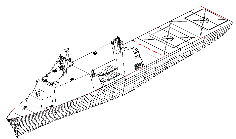|
Executive Summary
 The design is based on the assumption that future Naval forces would find themselves operating in littoral areas, intervening in regional conflicts and needing to respond to varying kinds of mission demands with flexible forces. It was agreed that a two-stage system, consisting of a "mother" ship which carried numbers of surface and air craft of varying kinds and capabilities offered the most promise for an affordable system that was rapidly re-configurable (by changing the load of carried "2nd stage" craft) to meet unpredictable tactical needs. The mother ship was dubbed the "Carrier Multi-Mission Dock" (CMD) and the carried craft, whether air or surface, were called Tactical Patrol Craft (PTX). The combination is referred to as the SPECTRE system. The nature of the PTXs had been examined in an earlier design exercise and craft capable of performing in six warfare areas had been preliminarily defined. The design is based on the assumption that future Naval forces would find themselves operating in littoral areas, intervening in regional conflicts and needing to respond to varying kinds of mission demands with flexible forces. It was agreed that a two-stage system, consisting of a "mother" ship which carried numbers of surface and air craft of varying kinds and capabilities offered the most promise for an affordable system that was rapidly re-configurable (by changing the load of carried "2nd stage" craft) to meet unpredictable tactical needs. The mother ship was dubbed the "Carrier Multi-Mission Dock" (CMD) and the carried craft, whether air or surface, were called Tactical Patrol Craft (PTX). The combination is referred to as the SPECTRE system. The nature of the PTXs had been examined in an earlier design exercise and craft capable of performing in six warfare areas had been preliminarily defined.
Seven potential scenarios for employment of the SPECTRE system were investigated, resulting in the Required Operational Capabilities for the PTX and for the CMD. The primary focus of the design was on the nature of the CMD. A significant effort in threat assessment using the postulated scenarios resulted in a choice of combat system suite alternatives for the CMD itself In addition, various loadouts of PTXs were examined for the various employment scenarios, and finally the CMD combat system was chosen. The propulsion and other engineering major parameters were decided upon and feasibility studies of three different CMD alternatives, using the Navy's early stage design program (ASSET), were performed. The result of these feasibility studies was a decision to develop further the mid-size CMD alternative.
A preliminary design of the chosen CMD ship alternative included finalizing the propulsion plant selection, defining and analyzing the combat system architecture as well as the architecture for major Hull, Mechanical and Electrical systems. A series of ship arrangements studies was conducted and the Naval Architecture aspects of the ship were examined and verified to be acceptable. The report includes a manning study and numerous drawings of the ship as preliminarily designed. A design team-conducted analysis of their design is followed by eight appendices giving details and results of various portions of the design investigation.
More Information
The following documents are available for download.
- Main Report
PDF file, 5.48 MB.
- Appendices
ZIP archive, 8 files, 4.28 MB.
- View #1
An elevated port bow view of the ship which supports numerous smaller craft and helicopters in a littoral warfare scenario.
- View #2
An interesting viewing angle of the large mother-ship.
|